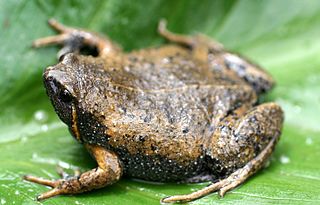
Hypopachus is a genus of microhylid frogs found in the Americas between Costa Rica and the southern United States. They can bury themselves under the ground or moss. Its name means ‘somewhat thick’, referring to its tough skin.

The Mexican narrow-mouthed toad is a species of sheep frog native to the Pacific and Caribbean lowlands from southern Texas to Costa Rica. Sheep frogs make a distinctive call that resembles a sheep's bleat during and after rainfall in warm months.
Rhinella amboroensis is a species of toad in the family Bufonidae that is endemic to the region of its type locality in the Carrasco Province of Bolivia and the adjacent Santa Cruz Department. Its common name is Cochabamba toad. It may exist in the Carrasco National Park and/or Amboró National Park, depending on its exact range.
Allobates mandelorum is a species of frog in the family Aromobatidae. It is endemic to the Cerro Turumiquire area in eastern Venezuela. Its natural habitats are cloud forest and subpáramo shrubland. It is threatened by habitat loss.
Aromobates haydeeae is a species of frog in the family Aromobatidae. It is endemic to Mérida and Táchira states in western Venezuela. Its natural habitats are clear, fast-flowing streams in Andean cloud forest and the puddles alongside the streams. They may sometimes hide inside introduced Pennisetum clandestinum grasses. The male protects the eggs that are laid on land. After hatching, the male carries the tadpoles on his back to water where they develop further.
Aromobates mayorgai is a species of frog in the family Aromobatidae. It is endemic to the Mérida state of western Venezuela. Its natural habitat is cloud forest where it occurs along mountain streams. The male protects the eggs that are laid on land. After hatching, the male carries the tadpoles on his back to water where they develop further.
Aromobates meridensis is a species of frog in the family Aromobatidae. It is endemic to the Cordillera de Mérida near Chorotal, Venezuela.
Eleutherodactylus dixoni is a species of frog in the family Eleutherodactylidae. It is endemic to Mexico. Its natural habitat is subtropical or tropical moist lowland forest. It is threatened by habitat loss.
Gastrophryne pictiventris is a species of frog in the family Microhylidae. It is found in northeastern Costa Rica and southeastern Nicaragua. This species is found in leaf-litter of lowland moist and wet forests. However, it is not easily seen outside the explosive breeding events. Breeding takes place in temporary pools.

Hypopachus barberi is a species of frog in the family Microhylidae. It is found in El Salvador, Guatemala, Honduras, and Mexico. This species is found in humid pine-oak forests at the elevations of 1,470–2,200 m (4,820–7,220 ft) asl. It is threatened by habitat loss due to logging.
Alvarado's salamander, also known as the Moravia de Chirripo salamander, is a species of salamander in the family Plethodontidae.
The dwarf splayfoot salamander, also known as the dwarf flat-footed salamander, is a species of salamander in the family Plethodontidae. It is endemic to southern Hidalgo, Mexico.
Limnonectes fragilis is a species of frog in the family Dicroglossidae. It is endemic to the Hainan Island, China. It is a medium-sized frog, males being 49 mm (1.9 in) and females 52 mm (2.0 in) snout-vent length. Its natural habitats are subtropical or tropical moist lowland forest and rivers. It is threatened by habitat loss.
Amolops jinjiangensis is a species of frog in the family Ranidae. It is endemic to China where it is found in Yunnan and Sichuan provinces. Amolops jinjiangensis is a common species inhabiting hill streams inside forests. It is threatened by habitat loss.
Amolops loloensis is a species of frog in the family Ranidae that is found in southern and western Sichuan and one locality in north-central Yunnan, China. Its natural habitats are small mountain streams in forests and grasslands. It is threatened by infrastructure development for human settlement, potentially also by water pollution from the mining industry. T

The giant Philippine frog, large swamp frog, or Mindanao fanged frog is a species of frog in the family Dicroglossidae. It is endemic to the Philippines. Its natural habitats are tropical moist lowland forests, subtropical or tropical moist montane forests, rivers, intermittent rivers, freshwater marshes, and intermittent freshwater marshes. It is becoming rare due to habitat loss.
Odorrana kuangwuensis is a species of frog in the family Ranidae that is endemic to China. It is found in northeastern Sichuan and northwestern Hubei. Its name refers to the type locality, Mount Guangwu in Nanjiang County, northern Sichuan.
Odorrana lungshengensis is a species of frogs in the family Ranidae that is endemic to China. It is found in northeastern Guangxi, southwestern Hunan, and eastern Guizhou. Its natural habitats are hill streams in broad-leaf forests. It is becoming rare due to habitat loss.

The Montezuma leopard frog, Lithobates montezumae, is a species of frog in the family Ranidae endemic to Mexico. Its natural habitats are pine-oak or oak forests above 2,000 m (6,600 ft) asl but it can also survive in moderately altered habitats. It breeds in lakes and big pools. It is potentially threatened by habitat loss and introduced predators. It is also collected for human consumption.
The Xingan salamander is a species of salamander in the family Hynobiidae, endemic to China: it is only known from its type locality, Mao'ershan in the Xing'an County, Guangxi. Its natural habitats are marshes and the surrounding forests. It is threatened by habitat loss and, living close to the summit of Mao'ershan at around 2,000 m (6,600 ft) asl, by climate change. It occurs within the Mao'ershan National Nature Reserve.





